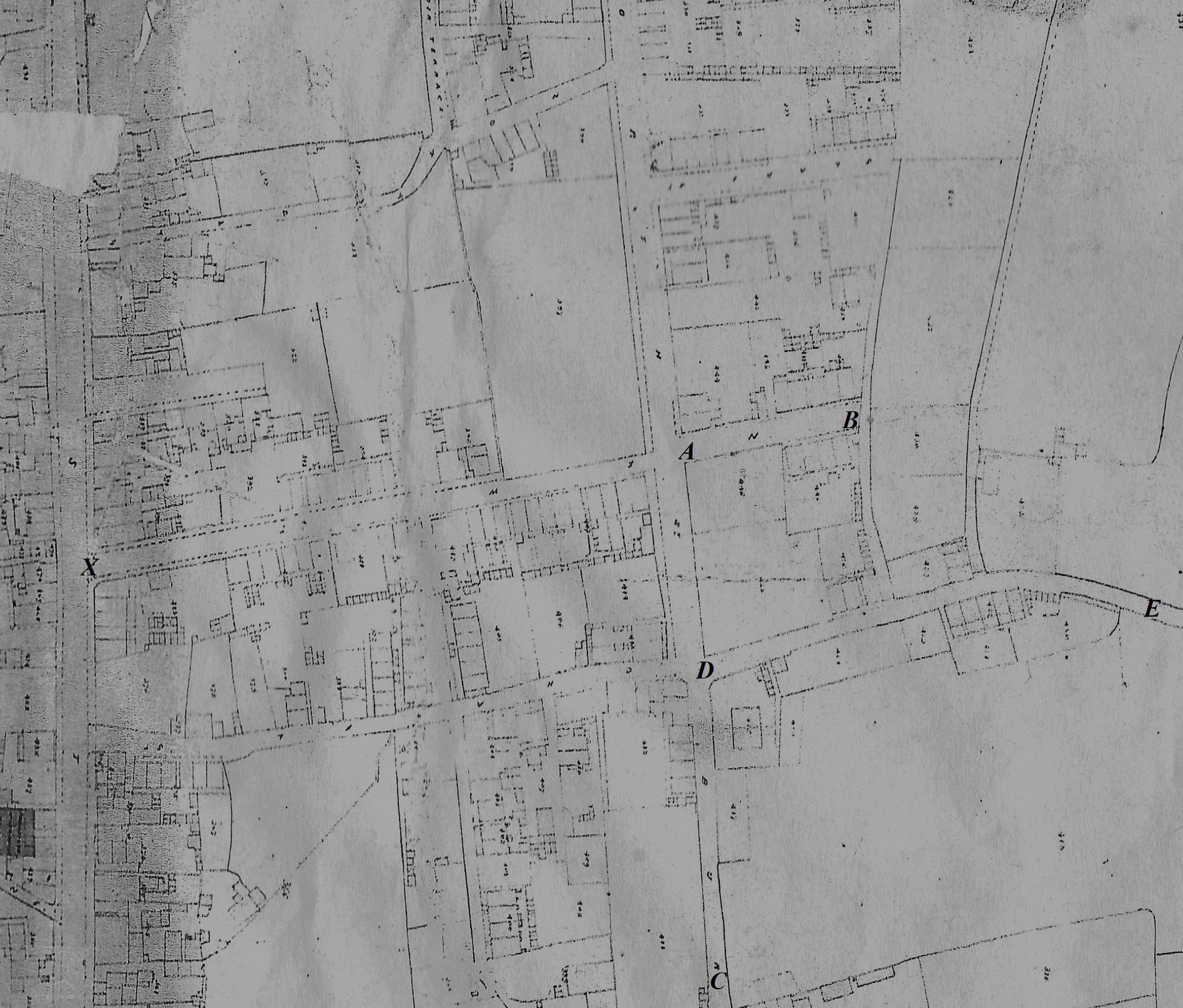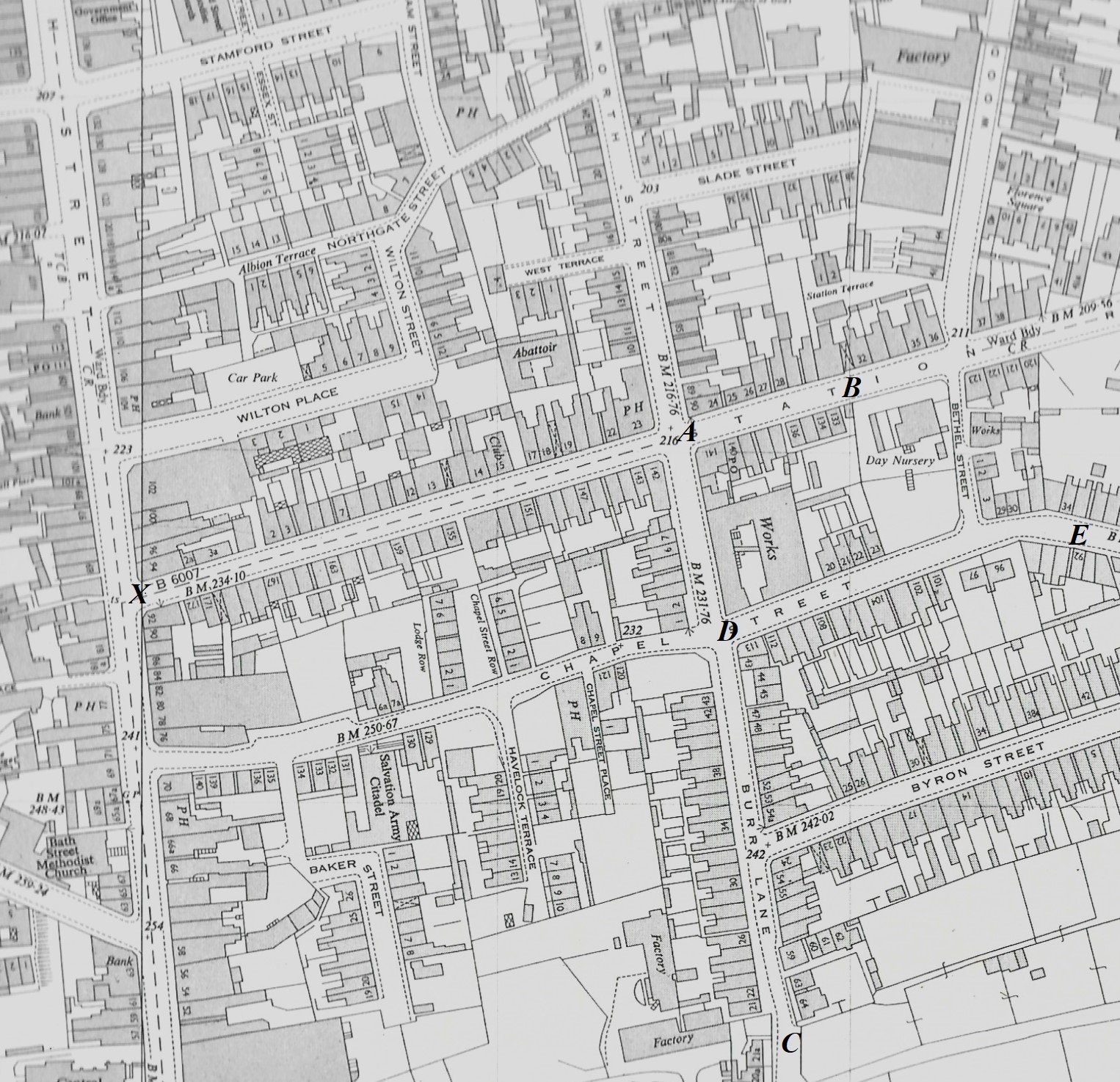We are now at the Bath Street/Station Road corner. The first map below is taken from the Local Board Map of 1866. Notice that New Street is still called that name; that is because it was a new street then !! It wasn’t called Station Road because, at that time it stopped, as a cul-de-sac, a long way from the railway station at Ilkeston Junction. It changed its name about 1870. Adeline describes this area: “New Street, now Station Road, was a cul-de-sac, a hedge dividing it from Burr Lane”. We are standing at X.
The map below shows the same area about 100 years later.
The first section of the street to be laid out was a very short cul-de-sac, about 40 yards in length, lying to the east of North Street, from A to B. In the late 1850’s this curious cul-de-sac was known as ‘Great East Street’.
By 1863 New Street had been built from Bath Street up to North Street (from X to A) and then beyond (from A to B), taking in the existing short cul-de-sac, which thus lost its original and separate name. However New Street did not continue to Ilkeston Junction but ended as a cul-de-sac, at B. Beyond its end were a few houses in the direction of Cossall Marsh. There was no Mill Street, Wood Street, or the rest, as we know them today. Instead Norman’s Long Close led from Chapel Street to Slack Road.
“At this time all carriage traffic from Ilkeston to Cossall had to proceed down Burr Lane. Chapel Street was also a cul-de-sac”, Adeline tells us.
On the maps this is from C, down Burr Lane to D, and then eastwards to E (along the route of mosern-day lower Chapel Street and towards Cossall).
Writing in 1917 Old Resident maintained that New Street, when first laid out, ended at what was later the grocer’s and baker’s shop of Henry ‘Harry’ Trueman. In the first quarter of the twentieth century (at least) this was 31 Station Road. Born in 1860 Harry Trueman was the son of William Severn Trueman alias Flinders and Emily Thompson Scattergood who married in 1855.
When Emily died in 1867 Harry was ‘adopted’ by his half-aunt Mary Thompson who was married to grocer Luke Beardsley. On the 1871 census the three of them are at 16 New Street.
Next door at 17 New Street is the family of Heanor-born coalminer George and Ruth Johnson.
Ruth was the daughter of Elijah Trueman and Hannah (nee Chambers) and her first husband, Benjamin Longdon, had died in 1861.
Before her second marriage, to George in 1864, she gave birth to her illegitimate daughter Evelina Raynor Longdon who is also at number 17.
In 1882 Evelina and Harry married. They both died at 31 Station Road, in 1912 and 1925 respectively.
———————————————————————————————————————————————
Adeline writes that “when the branch railway to the Junction was stopped, a few of the principal residents had the hedge removed from New Street and improved the road to the Junction, so that people could walk in comparative comfort. New Street was then renamed Station Road.”
Steps to extend the road to the new Junction Station began in the autumn of 1867. Fence post and rails were set out and the route was levelled ready for metalling. Responsibility for the road, eastwards to the Erewash Canal, lay with the Local Board; from the canal to the Junction Station was to be the work of the Railway Company. However it was not complete by the time of the opening of the new and improved Junction Station in November of 1867.
In 1870, acting on a proposal by William Wade, the Local Board agreed that New Street should now be named Station Road. A few Board members tried unsuccessfully to retain the original name and place a sign at the Bath Street end of the road with the words ‘To the Station’.
———————————————————————————————————————————————
1870 onwards …. and a new street takes shape.
Adeline describes what needed to be improved ….“It was a nasty dreary walk to that station. Those who had to go to Nottingham by the early morning train had to face all kinds of weather. There being no bus or conveyance of any kind, it was no unusual thing for people to be thoroughly wet by the time they reached the station. When there the waiting room would be cold and cheerless, but the waiting shed across the line was even more dreary, so people waited in the cold room until the train was signalled, and then walked across the low crossing opposite the station to get into the train.
Travelling in those days was not the comfortable affair that it is today. When the Trent Junction was reached, Nottingham passengers had to change, and then came a tiresome wait, until the Erewash Valley train came in that would take them to Nottingham, through Attenboro’ and Beeston.”
In 1871 a letter appearing in the Pioneer and written by a visitor to Ilkeston showed the state of the lower section of Station Road…. “a long reach of knee deep muddy cart ruts, buried here and there by pools of water, and with scarce the faintest trace of a footpath visible for a distance of several hundred yards”.
Complaints continued.
A correspondent to the Pioneer in January 1871, signing himself ‘Stuck Fast’, put the problem in a nutshell: “Here is a town of 10,000 inhabitants, thriving and prosperous, without a road to its railway station!”
Surely it was not beyond the wit of the Local Board and the Midland Railway Company to come together and resolve the problem, he pondered.
Visiting Ilkeston in 1872, a County Court Judge noted that in coming from the junction to the town people had “either to walk up to their knees in mud or be jolted in a lone-horse conveyance from one side to another”.
About the same time Thomas Hives ran a ’bus carriage to and from the station and the Pioneer was soon reporting problems.
“On Monday a serious accident occurred: the horse got his feet into one of the numerous bogholes along the road and while making an effort to rise, both the shafts on the carriage snapped, and the ’bus was upset, driver and passengers being thrown helter skelter over each other, and the parcels sent in all directions”.
Apparently Robert Wood, surgeon, had suffered a similar fate in North Street a few weeks earlier.
The Pioneer was clear where the blame lay; “people may well ask whether we have a Local Board in Ilkeston”.
In the summer of 1872 an agreement was drawn up between the Midland Railway Company and the Local Board in which the Company would pay £250 while the Board undertook the work of constructing, metalling, paving, kerbing, draining and fencing of the road from North Street up to the canal bridge.
Station Road was declared a highway by the Local Board by December of 1872.
After the road works were done there was a small surplus of income over the expenditure which was partially spent on a few street gas-lamps down to the Erewash bridge. (Feb 1873)
In June 1874 the Ilkeston Telegraph reported the cost of the new road to the station as a little over £320, inclusive of public lamps. Of this the Midland Railway Company had contributed £250 and £50 had been raised by public subscription. Thus little more than £20 had been the cost to the town’s ratepayers.
———————————————————————————————————————————————
Let’s now look at some of the families living in this area starting at Riley’s Row



